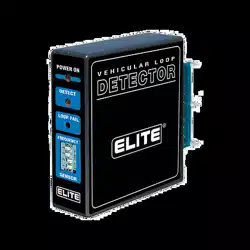
High Low
OFF
ON
Plug-In Loop Detector
for the OmniControl™ Board
Part # AELD
Dip Switch 1 - Sensitivity Level: The sensitivity is controlled by the setting of
switch1 on the front edge of the detector.
Note: Changing the sensitivity setting will automatically reset the detector.
Changing the frequency setting will not reset the detector. It is always necessary
to reset the detector after changing the frequency setting by t urning the gate
operator power off.
Dip Switch 2 - Boost on/off: When the switch 2 is off, the sensitivity boost is
disabled. When the switch 2 is on, the sensitivity boost is enabled. Boost enabled
will increase the sensitivity to detect high profile vehicles.
Dip Switch 3 & 4 - Frequency: The operating frequency of the detector is
controlled by the setting of switches 3 and 4 on the front edge of t
he
detector. Sometimes when
buried loops are in close proximity to each other, it
may be necessary to select different frequencies for each buried loo p to
avoid loop interference (commonly called crosstalk). The actual loop operating
frequency is a function of the size of the loop, the number of turns in the
loop, the length of the lead-in cable, and the setting of the frequency
switches (SW 3 & 4) . Therefore, setting one detector to Low and the other
to High may not provide any separation of o perating frequency. The most
accurate method of setting the o perati
ng fr
equency of multiple detectors is to
use a frequency meter connected to the loop to actually read the operating
frequency. The detectors fre quency should be adjusted so th at there is a
minimum of 5 kilohertz of separation between all adjacent loops.
LED Functions
– No Power
ON
– Power Applied
– No Presence
ON
– Presence Detected
– Loop OK
.5 Hz Flash
– Open Loop
3 Hz Flash
– Shorted Loop
Dip Switches
Dip Switch Functions
www.chamberlain.com
•
•
•
•
The “FAIL” LED indicates whether or not the loop is within tolerances. If the
loop is out of tolerance, the LED indicates whether the loop circuit was
shorted (3Hz Flash) or o pen (.5 Hz Flash). When the detector is detecting a
loop failure it will force a call output and the CALL LED will be on. If the loop
problem corrects itself, the detector will begin operating normally again and
the Fail LED will revert back to the Off state.
Failed Loop Diagnostics
Mark the loop layout on the pavement. Remove sharp inside corners that
can damage the loop wire insulation.
Determine the thickness of the pavement to ins ure that the depth of the
cut will not exceed the thickness of the pavement before attempting to
cut the loop slots. Set the saw to cut a depth (typically 2" to 2.5") that
will insure a minimum of 1"from the top of the loop wires to the pavement
surface. The saw width must be larger than the diameter of the loo p wire
to avoid d amage to the wire insulation when placed in the saw cut. Cut
the loo p, corner angles, and feeder slots. R emove all debris fro m the
saw slot with comp
ressed air. Che
ck that the bottom of the cut is smooth
and did not break though the thickness of the pavement.
Loop Installation
1
2
F
IRE
DE
PT
.
SYS
TEM ON
E
XIT
LOO
P
AL
A
RM
SE
NSOR
SAFETY
LOOP
OP
EN LE
FT
SENSORS
COMM
A
ND
PROC
ESSED
CEN
TE
R SA
FETY
EXIT
1
3
G B
MS L
INK
A
CENTER
SAFETY
EXIT
CENTER SAFETY EXIT
6 twists per ft from Loop
Turn the power
OFF
to the gate operator.
Plug in the loop detector in the desired slot
(i.e. center, safety, exit)
Plug in the terminal plug (provided) into terminal
J8 receptacle on the botto m left of the Omni board.
Bring twisted wires from the loop into the proper
terminal on the terminal plug (i.e. center, safety,
exit).
Turn the power back on.
Caution:
If using more than 1 loop
detector, set them to
different frequ encies.
(Refer to Dip Switch 3 & 4)
1.
2.
3.
4.
5.
Plug-In Loop Detector Installation
STRIK
E
OPEN
RE
VERSE
SEN
SOR
1
3
www.chamber
lain
.c
om
detector
vehicular loop
Plug-In Loop Detector
for Liftmaster
Enabled Controllers
MODEL # A E L D
now with BOOST CONTROL
Loading ...
